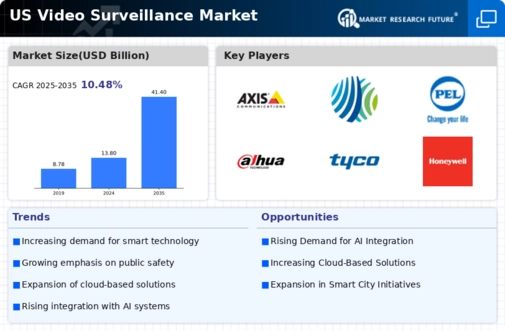Growing Security Concerns
Rising security concerns among businesses and individuals are propelling the video surveillance market forward. With increasing incidents of theft, vandalism, and other criminal activities, organizations are investing heavily in surveillance systems to protect their assets. A survey indicated that 70% of businesses in the US consider video surveillance a critical component of their security strategy. This heightened awareness of security risks is leading to increased adoption of advanced surveillance technologies, such as AI-driven analytics and remote monitoring capabilities. Consequently, the video surveillance market is likely to see sustained growth as stakeholders prioritize safety and security measures.
Emergence of Smart Home Technologies
The emergence of smart home technologies is reshaping the landscape of the video surveillance market. As consumers increasingly seek integrated security solutions, the demand for smart cameras and home monitoring systems is on the rise. Reports suggest that the smart home market is projected to reach $174 billion by 2025, with video surveillance systems playing a crucial role. These systems often feature remote access, mobile notifications, and AI capabilities, appealing to tech-savvy consumers. This trend indicates a shift towards more personalized and user-friendly surveillance solutions, which could further drive growth in the video surveillance market as homeowners prioritize security and convenience.
Increased Government Spending on Security
Increased government spending on security initiatives is a key driver of the video surveillance market. Federal, state, and local governments are allocating substantial budgets to enhance public safety through advanced surveillance technologies. For instance, the US government has earmarked over $2 billion for urban security projects, which include the installation of comprehensive surveillance systems in public spaces. This funding not only supports the deployment of cutting-edge technology but also fosters collaboration between public and private sectors. As a result, the video surveillance market is likely to benefit from this influx of government investment, leading to broader adoption and innovation in surveillance solutions.
Expansion of Retail and Commercial Sectors
The expansion of the retail and commercial sectors in the US is significantly influencing the video surveillance market. As businesses seek to enhance customer experience and ensure safety, they are increasingly adopting sophisticated surveillance systems. The retail sector alone is expected to invest over $5 billion in video surveillance solutions by 2027. This investment is driven by the need to monitor customer behavior, prevent theft, and ensure compliance with safety regulations. Furthermore, the integration of video analytics into surveillance systems allows retailers to gain insights into consumer patterns, thereby enhancing operational efficiency. This trend underscores the vital role of video surveillance in modern retail environments.
Technological Advancements in Surveillance Equipment
The video surveillance market is experiencing rapid technological advancements, particularly in camera resolution and data storage capabilities. Innovations such as 4K and 8K video resolution are becoming standard, enhancing image clarity and detail. Additionally, the integration of cloud storage solutions allows for scalable data management, accommodating the increasing volume of surveillance footage. According to industry reports, the market for high-definition cameras is projected to grow at a CAGR of 15% through 2026. These advancements not only improve the effectiveness of surveillance systems but also drive demand across various sectors, including retail, transportation, and public safety, thereby significantly impacting the video surveillance market.





















Leave a Comment